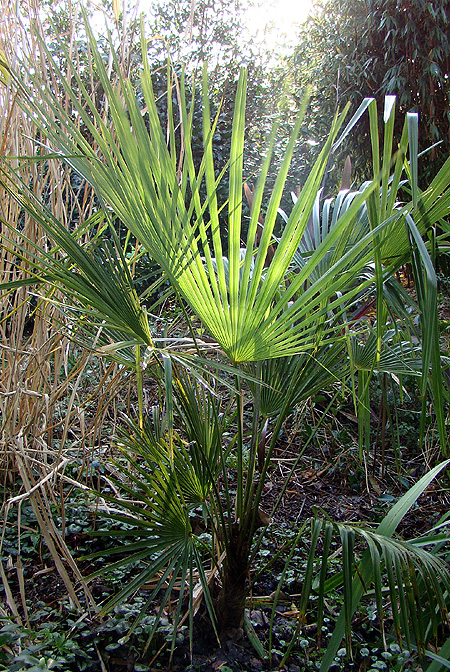“Is that possible here?” someone asked recently during a tour of my garden, pointing to a large Trachycarpus which had been planted out. I have noticed that some visitors give me a glassy look of disbelief when I tell that Palm trees have been in the garden for years, so I replied: “Yes, these palms do well in our climate.” “Yes, but should it?” said the visitor, needing further confirmation. This represents the feelings of a traditional group of gardeners who are not served by foreign exotics, you might say they are suffering from a certain horticultural xenophobia.
Thank goodness we don’t need licences for growing our palms! We can fill our gardens with asylum-seeking exotics if we want to.
Cultural requirements
Make sure that the ground drains well, that the palm is preferably protected from rain in winter and the palm is fertilized and watered well in summer. (Never allow fertilizer to get between or on the leaves, otherwise the heart may be affected!) During extreme cold, it is advisable to wrap the palm lightly with fleece cloth, reed mats, jute or something similar. Don’t use plastic because of the risk of fungus. Light heating such as Christmas lights mean the difference between life and death for the palm!
Rain protection is is the most important form of protection. This is because wet palms which subsequently freeze endure damage to the spear (the growth point at which new leaves grow), which can then rot. Young palms are more susceptible than old palms. Frequently palms will recover from frost damage in summer.
Fan palms and feather palms

The fan palm Trachycarpus ‘Manipur’ comes from India
The famous garden palm test is a fan palm, whose leaves all join a central leaf stalk at one point. It is the most suitable palm for our climate, and a good beginners palm. The much cheaper, fast-growing Washingtonia robusta (with spines on the leaf stalk and lighter green leaves with thread-like fibers) may respond poorly to our winters.
A well known feather palm is test, whose leaves range along a central leaf stem, rather like a fish bone. This cheap, fast growing species is not the hardiest palm, but with thorough winter protection it can be grown in gardens, especially in the coastal regions. The largest, hardiest feather palms for our climate are Butia eriospatha and the difficult Jubaea chilensis, both of which are very frost resistant once fully grown. The hybrid between Jubaea and Butia is Jubutia, much sought after by palm-nerds.
Trachycarpus wagnerianus is compact and has smoother leaves than T. Fortunei, and is therefore more popular.
Troublesome types are heat-loving species such as Sabal, Serenoa, Nannorrhops and Brahea. In our relatively cool summers they are difficult to grow. They are however very good patio plants!
Other species that are suitable for the garden are the very hardy Rhapidophyllum hystrix, the robust Trachycarpus Naini Tal (previously distributed as T. takil), the newcomer Trachycarpus princeps (including a weaker form known as ‘sp. Nova’) and Chamaerops humilis (including various beautiful varieties such as ‘Vulcano’ and ‘Cerifera’).
These days palm traders are plentifold. Not all of them boast adequate knowledge and experience. Remember that a good palm garden is only achieved with love, patience and good advice from experienced enthusiasts. Plant preferably in the spring, and preferably 5-10 year-old plants. Only plant very large palms with great care and if they have a well developed root system.
See our palm assortment ..

